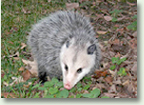
When your Nuisance Animal is an Opossum...
 Opossums, like most other animals, are susceptible to infection by the rabies virus; however, very few rabid wild opossums have been documented. Extremely high doses of the virus have been required to experimentally infect opossums as they seem to be highly resistant to the disease. Even though they do not often carry rabies, opossums can still deliver a nasty bite.
Opossums, like most other animals, are susceptible to infection by the rabies virus; however, very few rabid wild opossums have been documented. Extremely high doses of the virus have been required to experimentally infect opossums as they seem to be highly resistant to the disease. Even though they do not often carry rabies, opossums can still deliver a nasty bite.
Nuisance Problems
Opossums are called generalists because they will eat just about anything they can find. This can cause problems in areas where humans exist.Opossums will get into garbage cans; and eat pet food and cultivated fruits and vegetables. They may prey on poultry and their eggs, and enter homes through ripped screens or vent and duct systems.
To alleviate these problems and keep the opossum outside where it belongs, you can fasten garbage can lids with a rubber strap or bungee cord from hardware stores, and repair or cover holes in screens or building foundations. Do not leave pet food out at night. If the problem is extreme, you can surround your gardens with electric fencing.
You may lawfully live-trap the animals yourself, but your best bet is to call a licensed wildlife trapper. Sardines and cat food are effective baits. Once an animal is caught, however, another problem is created--what to do with it. Trapping and relocating wildlife is seldom biologically sound. Areas that appear suitable as release sites probably are not. Relocation to occupied areas causes problems for both the relocated animal and the resident population of the same species. In many respects, the soundest biological decision is to humanely destroy the nuisance animal. Relocation permits from the Florida Game and Fresh Water Fish Commission and permission from the landowner are required to transport and release any native wildlife species, and these permits are seldom issued for the reasons noted above.
Credits
Taken from document WEC28, one of a series of the Wildlife Ecology and Conservation Department, Florida Cooperative Extension Service, Institute of Food and Agricultural Sciences, University of Florida. Original publication date June, 1991. Revised September, 2002. Reviewed September, 2002. Revised December, 2006. Visit the EDIS Web Site at http://edis.ifas.ufl.edu.
Authors: Ruthe Smith, former wildlife assistant, and Joe Schaefer, Ph. D., urban wildlife specialist, Cooperative Extension Service, Institute of Food and Agricultural Sciences, University of Florida, Gainesville, 32611.
Copyright Information
This document is copyrighted by the University of Florida, Institute of Food and Agricultural Sciences (UF/IFAS) for the people of the State of Florida. UF/IFAS retains all rights under all conventions, but permits free reproduction by all agents and offices of the Cooperative Extension Service and the people of the State of Florida. Permission is granted to others to use these materials in part or in full for educational purposes, provided that full credit is given to the UF/IFAS, citing the publication, its source, and date of publication.
|
|
||
Contact a USA Animal
Control Professional
in your area.
